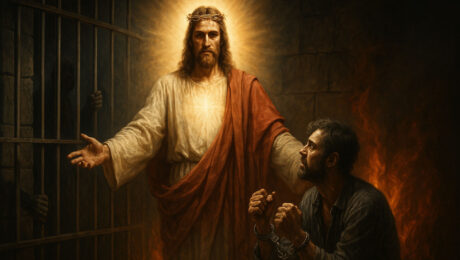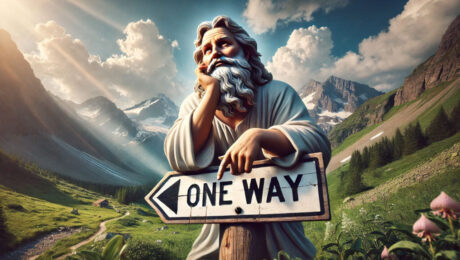Stockholm Syndrome Prison

The Prison of Belief: Stockholm, 67 Holmium, and the Savior’s Spell
Humanity lives in a kind of spiritual and psychological prison—one not made of iron bars or concrete walls, but of inherited belief systems, deep emotional conditioning, and the repetition of stories so powerful they shape generations. At the heart of this global cell is “The Greatest Story Ever Told”: the tale of Jesus Christ, the Savior who offers eternal life in exchange for belief, loyalty, and submission. It is a story reinforced by 501(c)(3) tax-exempt churches, free to broadcast this doctrine without government interference, yet firmly integrated into the governing structure. It has become both sanctuary and system, salvation and sentence.
The story begins with a mystical origin: the Immaculate Conception—a phrase steeped in Latin sacredness and, interestingly, carrying a numerical value of 164 in Latin numerology. This number correlates directly to Holmium, element 67 on the periodic table, which has the average isotope of 164.930. It also syncs perfectly with the name Emmanuhel’s Numerology of 67 (Latin Version). this comes from the very FIRST time Jesus is mentioned in the Bible — Isaiah 7:14. Holmium 67, named after Holmia, the Latin name for Stockholm, Sweden, now becomes an esoteric key. The connection is not random—this is a cipher of human psychology and captivity.

Stockholm, of course, is where the term Stockholm Syndrome was born—a psychological condition in which victims form emotional bonds with their captors. When applied symbolically, humanity itself becomes the hostage, emotionally attached to the very figure—Jesus—who represents both savior and system. Through this lens, the mass defense of Jesus across centuries of crusades, wars, and tribulations is not just devotion, but a global manifestation of Stockholm Syndrome: loyalty to the story that claims to liberate, but only after death, and only through submission.
In this mythic framework, Jesus emerges as the divine captor cloaked in light—promising eternal life, but only through suffering, guilt, and unwavering allegiance. This system, upheld by the tax-exempt religious complex, renders the narrative sacred and unchallengeable. Yet buried in the numerology and isotopic code lies the hidden liberation: once we recognize the captivity, we are no longer tethered to its dualistic construct. The choice between light and dark—heaven or hell, savior or sinner—is a mechanism designed to keep us choosing, endlessly. But when we see both sides as reflections of the same controlling coin, the spell breaks. Only then can we step beyond the game entirely, and walk free.
- Published in Uncategorized
ASSIGNED AT BIRTH

People Do Not “Choose” Their Own Lives – Their Programming is assigned at birth.
If you were in control of your thoughts, wouldn’t you choose positive thoughts and Peace of mind every time? If life were based on free will, people would be able to override their programming, but this never happens in reality. Instead, things like this happen:
A child born into an abusive home is likely to repeat the cycle—they did not choose their trauma, yet their experiences shape their behavior which shape their programming.
A person with mental illness, genetic predispositions, or neurological conditions does not choose their struggles—these are preordained factors that define their thoughts and actions – just like a Serial Killer.
Even our thoughts arise involuntarily—people have intrusive ideas, compulsions, and reactions they cannot control, proving that we do not originate our own thinking.
THEOLOGICAL SUPPORT OF NO FREE WILL
Job 42:2 – “I know that You can do all things, and that no purpose of Yours can be thwarted.”
God’s will is unbreakable—humans do nothing but follow their assigned role.
Jeremiah 13:23 – “Can the Ethiopian change his skin or the leopard its spots? Neither can you do good who are accustomed to doing evil.”
People cannot change their nature, meaning their fate is preordained.
Romans 9:21-22 – “Does not the potter have the right to make from the same lump one vessel for honorable use and another for dishonor?”
People are not blank slates—they are created for a specific destiny, whether to be good or evil.
Isaiah 45:7 – “I form the light and create darkness; I bring prosperity and create evil; I, the Lord, do all these things.”
God doesn’t just allow evil—He creates it. The wicked are not acting of their own will; they are fulfilling their programming.
John 6:70 – “Have I not chosen you, the Twelve? Yet one of you is a devil!”
Jesus identified Judas as his betrayer long before the betrayal happened, proving that his role was preordained.
If Judas was destined to betray Jesus, then he never had the ability to resist.
If Jesus was destined to be crucified, then he never had the ability to walk away.
If prophecies had to be fulfilled, then all events were scripted, leaving no room for deviation.
Even outside biblical theology, modern philosophy and physics suggest that we live in a deterministic system where every event is prewritten. Neuroscience shows that decisions are made in the brain before we are consciously aware of them—supporting heavily that choice is an illusion.
Conclusion: Life is Prewritten, and Choice is the complete Illusion
People only follow the programming assigned to them by genetics, environment, and divine decree. Every decision they make is simply the unfolding of a prewritten script, shaped by forces outside of their control. From the moment of birth, their circumstances, mental framework, and behavioral tendencies are already set in motion, ensuring they will act exactly as they were designed to act. The Bible affirms this reality, showing that both the righteous and the wicked are vessels created for their specific purpose (Romans 9:21-22). Even thoughts are not self-originated, as they arise spontaneously from conditioned neural pathways, making even internal reflection part of the deterministic process. Whether one believes in scientific determinism, divine predestination, or encoded reality, the conclusion is the same: human autonomy is an illusion, and every life is merely the execution of what was always meant to be.
- Published in Uncategorized
PREDESTINATION – JUST ONE WAY

Predestination and the Illusion of Free Will
If all things are made by God and for God, as stated in Colossians 1:16, and He directs human steps according to Proverbs 16:9, then human responsibility becomes an illusion.
For by him were all things created, that are in heaven, and that are in earth, visible and invisible, whether they be thrones, or dominions, or principalities, or powers: all things were created by him, and for him. – Colossians 1:16
A man’s heart deviseth his way: but the Lord directeth his steps. – Proverbs 16:9
Man’s spirit is not his own, as Genesis 6:3 declares, and all of creation serves divine purpose. Even human plans unfold according to a predetermined script.
“MY spirit shall not always strive with man, for that he also is flesh.” – Genesis 6:3
Job 41:11 affirms that nothing is truly owned by man, not even his actions, as God states, “Everything under heaven is Mine.” If some are predestined for salvation, as outlined in Ephesians 1:5, then free will is irrelevant, and every soul’s role—whether as a saint or a betrayer—is already written.
Having predestinated us unto the adoption of children by Jesus Christ to himself, according to the good pleasure of his will. – Ephesians 1:51
Judas Iscariot and the Nature of Predestination
Jesus’ selection of Judas as the betrayer in John 13:26-27 and His statement that Judas was “lost so that Scripture might be fulfilled” in John 17:12 suggest that his betrayal was not a matter of choice but a divine assignment. Similarly, Pharaoh’s heart was hardened by God in Exodus 9:12, indicating that resistance was never an option. If judgment is based on moral responsibility, then how can one be held accountable for an action they were destined to fulfill? Romans 9:21 confirms that God, as the potter, shapes some vessels for honor and others for destruction, indicating that judgment is simply the unfolding of a preordained design.
Judgment as a Preordained Reality
If all actions—good and evil—are scripted, then judgment is not a moral test but a final act in the divine play. Jesus states in John 19:11, “You would have no power over me if it were not given to you from above,” reinforcing that even those who crucified him did so because it was decreed. Isaiah 55:8-9 affirms that God’s ways are beyond human comprehension, meaning that judgment serves a purpose outside of human logic. Rather than being about justice, it is simply the means by which predestination is fulfilled, dividing souls according to their preordained paths.
The Law of One and Ra as the Divine Source
The Law of One, channeled from Ra, teaches that all things—both light and darkness—are manifestations of the One Infinite Creator. If reality is scripted, then good and evil are not opposing forces but necessary polarities within a singular consciousness. Revelation 3:15 reinforces this principle when Jesus rebukes the lukewarm, stating, “I would that you were hot or cold.” This perspective suggests that polarization is necessary for spiritual evolution. Souls must choose between service to others, representing light, or service to self, representing darkness, yet both paths ultimately serve the One.
Lukewarmness as Transcending Duality
Choosing to be lukewarm, neither fully light nor fully dark, is also predetermined. Revelation 3:16 states that the lukewarm will be “spit out,” which, rather than signifying condemnation, indicates a transition beyond duality.
Since Jesus declares that He will spit the lukewarm out of his mouth, this implies that they were already within Him before being expelled. If they were in his mouth, they were part of Him, signifying a connection to the material world of which he is speaking from. This act of being “spit out” does not necessarily indicate abandonment, but rather a purging or transformation, much like gold being refined through fire. The lukewarm soul, not designed to progress within the polarity system of duality, undergoes refinement and is redirected toward a neutral state of pure consciousness. Instead of failing, they move beyond the illusion of opposition, transcending the framework of good and evil and moving outside of duality itself, perhaps returning to the One Infinite Creator in its purest, unpolarized form.
The One as the Author of All Path
If Ra, the One Infinite Creator, is God, then all actions, choices, and judgments are part of the One’s self-exploration. What appears as punishment is merely the completion of each soul’s role within the grand illusion. Whether one aligns with light or darkness, betrays like Judas, or serves like Christ, all paths lead back to the One, and free will is nothing more than an experiential illusion within a prewritten story.
Matthew 25:41 strengthens the argument for predestination with the word ἡτοιμασμένον (hētoimasménon), meaning “prepared beforehand,” which strongly implies that eternal judgment was set in place before time. The fact that eternal fire was preordained before the judgment scene unfolds indicates that its existence was not a reaction to sin but part of the divine plan from the beginning. If Hell was established in advance, then God foreknew and accounted for the devil, his angels, and those who would follow them into condemnation. This supports the theological argument that certain souls were always destined for eternal separation from God, not as an unintended consequence but as an integral part of divine foreknowledge and order.
The concept of predestination is reinforced throughout many Scriptures, affirming that God has preordained both salvation and condemnation according to His divine will. Romans 8:29-30 explicitly states,
“For those whom He foreknew, He also predestined to be conformed to the image of His Son… and those He predestined, He also called.“
This establishes that salvation is not a random choice by man but a predetermined act of God. Likewise, Romans 9:22 affirms the existence of “vessels of wrath prepared for destruction,” implying that just as some are destined for eternal glory, others are destined for judgment. John 6:44 declares,
“No one can come to Me unless the Father who sent Me draws him.“
This reveals that even faith itself is not an autonomous human decision but the result of divine selection. Proverbs 16:4 further solidifies this, stating,
“The Lord has made everything for its own purpose, even the wicked for the day of disaster.”
If God has prepared Hell beforehand, as stated in Matthew 25:41, and predestined both the saved and the lost, then human free will is merely an illusion, as every soul is simply playing out its preordained role in the divine script.
The Illusion of choice
If eternal fire was prepared before the creation of humanity, then human choices become illusory, as their final destination was already known and established by God. This challenges the notion of free will, as those who are condemned were created with the knowledge that they would ultimately end up in eternal punishment. The verse suggests that God did not merely allow Hell to exist but actively designed it for a specific purpose, which implies that those who enter it were also preordained to be there. Just as salvation is described as predestined in Ephesians 1:5, this verse supports the idea that damnation is equally predetermined, reinforcing a deterministic view of reality where some are vessels for honor and others for destruction, as stated in Romans 9:21-22.
Romans 9:11 emphasizes the doctrine of divine election, illustrating that God’s choice is based on His will rather than human actions. In the context of this passage, Paul refers to Jacob and Esau, stating that before they were even born—before they had done anything good or evil—God had already chosen Jacob to carry forth His covenant. This reinforces the idea that salvation is not dependent on human merit, but solely on God’s sovereign will. The verse underscores that God’s purpose in election stands apart from works, making it clear that grace, not effort, determines one’s place in God’s plan. This passage aligns with the broader theme of predestination, as also seen in Romans 8:29-30, where Paul states that God foreknows, predestines, and calls individuals according to His divine purpose.
Predestination is not merely a theological possibility but an undeniable fact when viewed through the lens of Scripture. From the foundation of the world, God has foreordained both the saved and the condemned, establishing an eternal order where every soul fulfills its prewritten role. The preparation of Hell beforehand (Matthew 25:41), the hardening of hearts (Exodus 9:12), the vessels of wrath and mercy (Romans 9:21-22), and the doctrine of divine election (Romans 9:11) all point to a divine plan where choice is an illusion and destiny is fixed. Even faith itself is granted, not chosen (John 6:44), proving that salvation is an act of God, not of human will. If all things exist by God and for God (Colossians 1:16), then even the condemned serve a divine purpose, fulfilling the will of the Creator rather than defying it. Free will is the illusion of experience, but predestination is the inescapable truth—a cosmic script written before time, where every step, every action, and every soul’s final destination has already been set.
- Published in Uncategorized
THE FUTURE OF CELL PHONES
WHAT IS THE NEXT STAGE OF EVOLUTION FOR OUR COMMUNICATION?
I’ve been asking myself and the world around me of what’s next for the evolution of cell phones — what will our world look like beyond what we’re using today in the form of Smartphones?
The Evolution of the Telephone: From Dial Phones to the Future of Communication
The evolution of communication technology has been a journey of innovation, moving from bulky, stationary devices to compact, intelligent, and highly integrated systems. The earliest widely used phones were rotary dial telephones, mounted on walls or sitting on desks, connected by a long cord. These phones required users to manually dial each number by rotating a circular dial, making communication a deliberate and somewhat slow process. Despite the limitations, they symbolized a breakthrough in personal connectivity, allowing people to reach each other instantly across distances without relying on letters or telegrams.

As technology advanced, pagers emerged as a new way to stay connected in the late 20th century. Initially, these devices could only beep or display a number, prompting users to find a phone to return the call. Eventually, word-scrolling pagers appeared, allowing for brief messages to be transmitted, revolutionizing instant communication for professionals, especially doctors and businesspeople.

However, pagers still lacked two-way conversation capabilities, leading to the next leap: the car phone in a bag. These early mobile phones were large, often installed in vehicles, and carried in a bag with a battery pack. They were cumbersome but represented the first taste of true wireless communication.
The brick cell phone, popularized in the 1980s, was the first handheld mobile phone that didn’t require a car connection. Large, heavy, and limited in battery life, these devices were initially a luxury for the elite but quickly gained traction as cellular networks expanded. By the late 1990s, flip phones became the dominant form of mobile communication, offering a sleek, compact design with improved battery life, text messaging capabilities, and even basic internet browsing. This period marked the transition from phones being purely about voice calls to becoming multimedia devices.

The smartphone revolution transformed communication forever. With the introduction of touchscreen technology, high-speed internet, and powerful processors, smartphones became an all-in-one tool for calls, messaging, video conferencing, social media, and even work productivity. Artificial intelligence and voice assistants like Siri and Google Assistant brought an entirely new level of user interaction, while app stores created an entire ecosystem of services that extended far beyond simple communication.

The Future of Phones: What Comes Next?
As we look ahead, the next stage of evolution in phone technology will likely move beyond physical devices entirely. With the rise of augmented reality (AR) and virtual reality (VR), smartphones may be replaced by wearable or implantable technology that integrates seamlessly with human biology. Brain-computer interfaces, like those being developed by companies such as Neuralink, may allow for thought-based communication, eliminating the need for touchscreens or even voice commands.
Another likely advancement is holographic projection technology, where devices will no longer need screens but instead create immersive, interactive 3D interfaces in midair. AI-powered assistants will continue to evolve, becoming even more intuitive, predictive, and personalized. Quantum communication and decentralized networks could also redefine how we connect, offering ultra-secure, near-instantaneous global communication without reliance on traditional cellular towers.

In essence, the future of phones may not even involve “phones” at all. Instead, we are moving toward a world where communication is instant, seamless, and deeply integrated with our daily lives, bridging the gap between the physical and digital worlds in ways that were once considered science fiction.
Communication towards Perfection
As instant communication evolves beyond physical devices into seamless thought-based interfaces, holographic projections, and AI-driven networks, society moves toward a state of heightened efficiency, understanding, and interconnectedness. The ability to instantly share knowledge, emotions, and solutions in real time fosters a world where collaboration transcends language barriers, misinformation is minimized, and decision-making is optimized through collective intelligence. With technology integrating directly with human cognition, innovation accelerates, leading to breakthroughs in medicine, governance, and education that eliminate delays and inefficiencies. In this perfected society, global consciousness expands as individuals operate with enhanced awareness, empathy, and shared purpose, forging a civilization where communication is no longer a barrier but the very foundation of unity, progress, and collective evolution.
- Published in Uncategorized
INFLUENCE OF THE AGES

Evolution of Programming
Human beliefs and behaviors have always been shaped by the environments they inhabit and the influences they encounter. Long before the advent of computers, television, and movies – books, oral stories, and gatherings served as the primary mediums for instilling and reinforcing ideas. These “old-school” methods were natural predecessors to the modern platforms that amplify beliefs through algorithms, demonstrating a continuous evolution in how societies are programmed.
Piscean Era
During the Piscean Age, society’s programming revolved around books, texts, and oral traditions. This era was symbolized by learning through community—the “school of fish”—where shared beliefs were passed down by elders, leaders, and religious figures. These authority figures acted as the gatekeepers of collective truth, shaping society’s moral compass through storytelling, scripture, and myth.
Stories shared at gatherings, inscribed on papyrus, or passed down through oral traditions served as powerful tools for reinforcing collective beliefs. These narratives provided a framework for interpreting the world and understanding one’s role within it, fostering a sense of identity and belonging within communities.
Equally significant was the role of symbolism and interpretation in daily life. People found profound meaning in celestial events, natural phenomena, and everyday occurrences. Symbols such as the rising sun, a hawk in flight, or the changing seasons were imbued with cultural significance, reflecting the values, aspirations, and spiritual connections of a society. These interpretations were often deeply personal yet aligned with the broader beliefs of the community, creating a shared sense of purpose and understanding.
The Piscean era was marked by communities relying on confirmation bias to uphold coherence in their shared truths. People naturally gravitated toward stories and narratives that aligned with their existing worldviews, forming an early version of the echo chambers we recognize today. Leaders through spoken words, and authors through written texts played pivotal roles in shaping these truths, guiding individuals toward lives deeply influenced by the external world and its prevailing cultural and societal norms.
Transition to the Age of Aquarius: Free-Flowing Knowledge
As humanity moves into the Age of Aquarius, the mechanisms of programming shift dramatically. This age, symbolized by free-flowing knowledge and technological abundance, brings about the rise of computers, movies, television, and artificial intelligence. Unlike the curated and centralized truths of the Piscean Age, Aquarius opened the floodgates to an overwhelming variety of information sources.
In the Aquarian age, algorithms have replaced elders and leaders as the primary curators of truth. Platforms like social media, search engines, and streaming services analyze user behavior to deliver personalized content. This creates a “reinforcement loop,” where individuals are consistently exposed to information that aligns with their beliefs. Over time, this tailored exposure solidifies their perspectives and limits their openness to alternative viewpoints, just like it did with the leaders during the Piscean Age.
Similar to traditional societies confined by cultural echo chambers, algorithms further narrow perspectives by filtering out contradictory ideas. This restricted exposure fosters polarization, as individuals become surrounded by like-minded thoughts and ideologies. This environment reinforces their sense of “rightness,” making them less likely to engage with differing perspectives.
The repetition of content, whether through books in earlier eras or modern digital platforms, contributes to one’s sense of consensus. People begin to believe their truths are universal, assuming widespread agreement where it may not exist within the truths of anything external outside of themselves. This perception fuels competition, expansion and individualism as people strive to prove others wrong and assert their own perspectives as the definitive truth.
The Natural Programming of Beliefs
Despite changes in medium—from papyrus scrolls to digital feeds—the underlying mechanisms of belief programming remain constant. Humans are naturally predisposed to seek patterns, construct narratives, and reinforce their worldview. The human mind acts as its own algorithm, constantly filtering experiences and perceptions based on past emotions, memories, and deeply held values. This internal narrative shapes how individuals interpret the world around them, guiding their reactions and decisions in a way that reinforces their existing beliefs and emotional states.
Symbols and their relevance play a significant role in this process. Whether it’s a story heard from a friend or a sign observed in nature, people naturally assign meaning to their environment that aligns with their worldview. These interpretations, often personal yet culturally influenced, allow individuals to make sense of their surroundings in ways that feel deeply resonant.
Before the advent of modern technology, communities themselves functioned as echo chambers, with traditions, norms, and shared values reinforcing collective truths. In today’s world, algorithms have amplified these tendencies, creating digital spaces that replicate and intensify the same dynamic. Through both natural and technological means, humanity continues to seek and reinforce patterns that resonate with their cultural and individual identities.
Divine Oversight: The Role of God and Astrology
Ultimately, whether through ancient storytelling or modern algorithms, all programming flows through a divine framework. God, acting as the ultimate source of order, uses the tools of each era to guide humanity’s evolution. During the Piscean Age, this manifested through learning and text. In the Age of Aquarius, it manifests through the abundance of knowledge and technology.
Astrology provides insight into this divine programming, with each age bringing its own methods of shaping human consciousness:
The Age of Pisces was a focus on introspection, learning, and spiritual connection through written and oral traditions. Papyrus, paper and books were the leaders of influence. But now the Age of Aquarius moves towards a proliferation of knowledge, innovation, and free-flowing information through machines, A.I., and digital platforms.
Conclusion
The progression from books and stories to algorithms and A.I. demonstrates the evolving methods by which society programs itself. While the mediums change, the essence of belief reinforcement remains rooted in human psychology, cultural traditions, and divine intention.
The Age of Pisces was characterized by a more deliberate and controlled approach to teaching, learning, and sharing knowledge. During this time, influence was centralized and often required significant effort to access. Written materials, such as those on papyrus or early paper, were precious and labor-intensive to produce. Writing or printing took time, resources, and skill, which made such texts less widely available. This scarcity inherently limited the spread of information and ensured that only select teachings or truths were disseminated, often under the careful control of leaders, scholars, or religious figures. This was Limited access.
Learning in this age required physical presence and active participation. To be influenced by a preacher, teacher, or leader, one had to set aside time to travel to a church, temple, or other gathering place. The process of acquiring knowledge or being exposed to new ideas was slow and deliberate, fostering a deep sense of introspection and connection to the material. Education and spiritual growth were steeped in tradition, and knowledge was seen as something earned through patience, effort, and discipline.
In contrast, the Age of Aquarius has ushered in a revolutionary shift toward instant access to information. Digital platforms, artificial intelligence, and the internet have removed many of the barriers that once limited the spread of knowledge. Audio books, podcasts, and online videos cater to a world with an average 7th-grade reading level, making learning more accessible to diverse audiences. With a smartphone or computer, anyone can access vast amounts of information at any time, eliminating the need for physical travel or extended waiting periods. This is Unlimited access.
Truth and influence in the Aquarian Age no longer require direct interaction with a leader or teacher. Virtual platforms provide instant access to sermons, lectures, and teachings from across the globe, all without leaving home. The internet has become the ultimate repository of free-flowing knowledge, where ideas proliferate at an unprecedented pace. This abundance of information encourages exploration and innovation, but it also presents challenges, such as navigating misinformation and information overload.
The divine operates seamlessly through all ages, transcending the mediums through which humanity is educated and influenced. Whether through the written texts and oral traditions of the Age of Pisces or the digital platforms and instantaneous knowledge of the Age of Aquarius, the divine works to guide human consciousness toward growth and evolution. Each medium serves as a vessel for divine wisdom, adapted to the needs and capacities of the time. In every interaction, whether through a preacher’s sermon, a book’s pages, or an online video, the divine sparks inspiration, self-discovery, and collective progress. No matter the tools or methods, the divine flows through every moment, shaping our understanding and awakening us to higher truths.
- Published in Uncategorized




